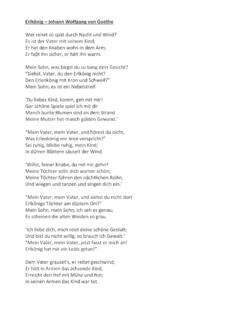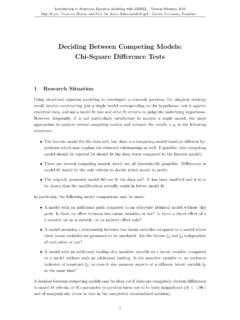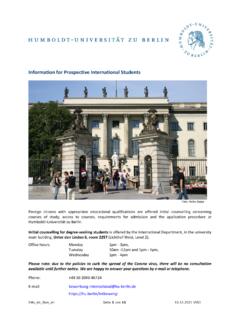Transcription of Culture in foreign language teaching - ed
1 Iranian Journal of language teaching Research 1(1), (Jan., 2013) 57-78 57 * Corresponding author: university of California at Berkeley, US Email address: Urmia university Press Urmia university In foreign language education, the teaching of Culture remains a hotly debated issue. What is Culture ? What is its relation to language ? Which and whose Culture should be taught? What role should the learners Culture play in the acquisition of knowledge of the target Culture ? How can we avoid essentializing cultures and teaching stereotypes? And how can we develop in the learners an intercultural competence that would shortchange neither their own Culture nor the target Culture , but would make them into cultural mediators in a globalized world? This paper explores these issues from the perspective of the large body of research done in Australia, Europe and the in the last twenty years. It links the study of Culture to the study of discourse (see, , Kramsch 1993, 1998, 2004) and to the concept of translingual and transcultural competence proposed by the Modern language Association ( , Kramsch, 2010).
2 Special attention will be given to the unique role that the age-old Persian Culture can play in fostering the cultural mediators of tomorrow. Keywords: Culture ; discourse; intercultural competence; modernist perspective; postmodernist perspective; foreign language Urmia university Press Received: 30 Sep. 2012 Revised version received: 4 Dec. 2012 Accepted: 12 Dec. 2012 Available online: 25 Dec. 2012 Culture in foreign language teaching Claire Kramsch a, * a university of California at Berkeley, US A B S T R A C T A R T I C L E S U M M A R Y Content list available at Iranian Journal of language teaching Research 58 Claire Kramsch/ Culture in foreign language teaching Introduction Despite the considerable amount of research dedicated to defining the nature, importance and place of Culture in foreign language study (see , Byrnes, 2002; Kramsch 1993, 1997, 1998; Lange & Paige, 2003; Risager, 2006, 2007), Culture remains a hotly debated issue in the teaching of foreign languages around the world.
3 The debates involve school curricula, language teachers and language learners. School curricula often delineate quite strictly language classes taught in the foreign language (L2) from literature or Culture classes that are taught in the L2 or in the students native language (L1). Indeed, under the influence of the communicative approach promoted by English as a Second language , language pedagogy that focuses on communicative competence and the acquisition of conversational skills is often quite different from literature pedagogy that focuses on the analysis, interpretation and translation of texts from one language into another. While the first deals with small c Culture of everyday life, the second deals with the big C Culture of literature and the arts. So the first debate about Culture is about which Culture should be taught: the specific life style of specific speakers of the language ? or a more general humanistic fund of wisdom as transmitted through literature and the arts?
4 language teachers are supposed to teach nothing but language ; Culture is reserved for the professors of literature. However, Culture becomes an issue when the language is taught by native speakers of the language . Many school systems prefer to hire native speakers (NSs) as language teachers because of their authentic relationship to the target language and Culture , but native speakers don t necessarily know the home Culture of their students nor the intellectual tradition of their school system. NSs represent an attractive exotic other but, as research has shown, they cannot act as models for learners who by definition will not become native speakers. Non-native language teachers have the advantage of having learned the language the way their students do but many of them feel inadequate when teaching an everyday Culture Iranian Journal of language teaching Research 1(1), (Jan., 2013) 57-78 59 they are not really familiar with. They are afraid of falling into the stereotypes promoted by the textbook and the marketing industry and prefer to remain on the safe ground of grammar and vocabulary.
5 So the second debate about Culture is about the goals of language study: is the goal to raise students awareness about language in general (MLA, 2007)? ; to give them the skills necessary to communicate with L2 speakers in a global economy? ; to enable them to travel to other countries as tourists or to seek employment abroad? ; or to become literary scholars and academics? foreign language learners themselves are of different opinions regarding the cultural component of foreign language study. Some learners feel threatened in their L1 identity by too much emphasis on Culture . Thus, for example, for the teaching of foreign languages in the , some students say: this is a language class. We don t want Culture rammed down our throats (Chavez, 2002). Others say: the language classroom is not really the place to learn about values, history and Culture .. some German instructors want to raise our consciousness about us being Americans. It s debilitating. (Kramsch, 2011, p.)
6 361). I suspect that for some who come from a modest social background, a feeling of inferiority or uncertainty about their own Culture might lead them to reject Culture altogether from language classes. However, these same students would find it quite all right for immigrants to learn not only the language but also the Culture of their host country. Others, who come from a more middle class background, are eager to learn about exotic cultures but are reluctant to see themselves as cultural beings: they see their Culture as universal and they learn another language and Culture primarily to better appreciate their own (that is how I learned German in France in the fifties). Yet others, indeed a majority of learners of English around the world, are keen on learning the language precisely because it gives them access to a Culture that they admire and a lifestyle they aspire to. For economic or emotional reasons, youngsters see in the foreign Culture new ways of dreaming of themselves (see Kramsch, 2009b).
7 At an age when they are trying to find out who they are, the foreign language very often symbolizes other cultural 60 Claire Kramsch/ Culture in foreign language teaching horizons. Of course, what they want to escape is precisely what they will seek to recover later, when they are 50 or 60. The challenge for the language teacher is to prepare them both for this voyage of discovery and for their return voyage when later in life, they will rediscover who they are in light of their encounter with the other. So the third debate about Culture is about issues of national and social identity in a world of rapidly changing demographics and where computer technologies and global television have increased the gap between generations. I will first propose a definition of Culture in its relation to language and to discourse. I will, then, survey the two different ways in which Culture has been researched in the last twenty years in applied linguistics, first from a modernist, then from a post-modernist perspective.
8 I will finally suggest that we might want to think less of teaching Culture than of developing in our students an intercultural competence steeped in a deep understanding of their historicity and subjectivity as language learners. 1. What is Culture ? When you step out of the Hall of Mirrors (Galerie des Glaces) in the palace (Ch teau) of Versailles onto the terrasse du ch teau, you have a magnificent view of a square pool of water (le parterre d eau) with, at each corner, a stone statue of a reclining figure representing each of the four main rivers of France: la Seine, la Loire, le Rh ne and la Garonne. This pool of water mirrors, by nice weather, the splendors of the interior architecture of the palace. It brings nature and Culture in harmony with one another for the greater glory of the Sun King. From this heightened perspective, your eyes then follow the cascading terraces and symmetrical floral patterns of the jardins la fran aise around various basins and fountains, down a long rectangular grass lawn called le tapis vert (the green carpet), bordered with carefully trimmed oak and chestnut trees and adorned with marble statues of gods and goddesses, all the way down toward the spectacular water fountains of the Bassin d Apollon, with its Iranian Journal of language teaching Research 1(1), (Jan.)
9 , 2013) 57-78 61 flamboyant bronze chariot driven by the Sun God and his racing horses, on to the wide open space of the Grand Canal, an expanse of water that stretches to the horizon and from there - seemingly - to infinity. Such splendor was the product of Le N tre s imagination, of course, but this imagination did not emerge from the malaria-infested swamp that Versailles was in the 17th century, nor from the gray skies and rainy climate of the Ile-de-France. As Culture goes, it drew on the collective memory of other gardens, under other skies, in other times. The floral patterns of the Versailles gardens bear an uncanny resemblance with the intricate patterns of Persian carpets, the parterre d eau echoes the delightful water pools of Persian paradises , the symbolic relationship of in-door dwellings and outdoor gardens mirrors the alleys and arcades of Persian gardens, even if the purpose in Versailles was not to avoid the heat and to enjoy the fruit trees like in Pasargad , nor to celebrate the union of the sky and the earth as in the Persia of 3000 years ago, but to exalt the power of the French monarchy in the person of the King.
10 But the Persian influence on Versailles is undeniable. I come from Versailles. Versailles is my hometown. I left it when I was 25 to find out who I was in a foreign tongue, under foreign skies. In the same manner as nature and Culture mirror one another in homes and gardens, and that Persian gardens have served as a mirror to French gardens that have themselves mirrored other gardens in other countries, language learners learn who they are through their encounter with the Other. They cannot understand the Other if they don t understand the historical and subjective experiences that have made them who they are. But they cannot understand these experiences if they do not view them through the eyes of the Other. It is only by understanding Versailles that I can understand the uniqueness of Babylon. In turn, Babylon helps me to understand the unique characteristics of my Culture . The Bakhtin scholar Michael Holquist (1990) calls this relationality of Self and Other dialogism.


















